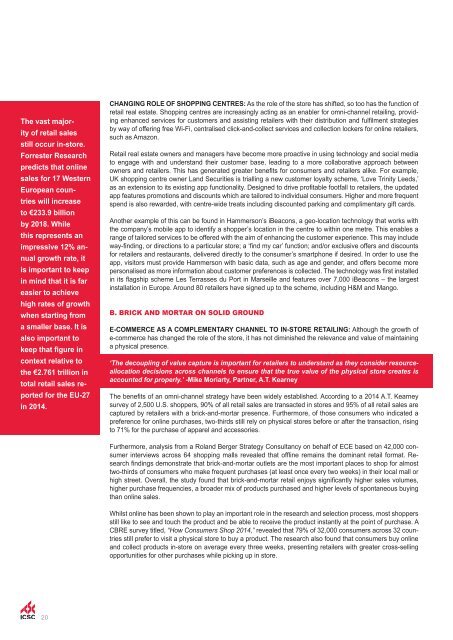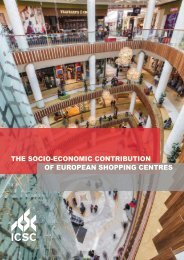THE SOCIO-ECONOMIC CONTRIBUTION OF EUROPEAN SHOPPING CENTRES
You also want an ePaper? Increase the reach of your titles
YUMPU automatically turns print PDFs into web optimized ePapers that Google loves.
The vast majority<br />
of retail sales<br />
still occur in-store.<br />
Forrester Research<br />
predicts that online<br />
sales for 17 Western<br />
European countries<br />
will increase<br />
to €233.9 billion<br />
by 2018. While<br />
this represents an<br />
impressive 12% annual<br />
growth rate, it<br />
is important to keep<br />
in mind that it is far<br />
easier to achieve<br />
high rates of growth<br />
when starting from<br />
a smaller base. It is<br />
also important to<br />
keep that figure in<br />
context relative to<br />
the €2.761 trillion in<br />
total retail sales reported<br />
for the EU-27<br />
in 2014.<br />
CHANGING ROLE <strong>OF</strong> <strong>SHOPPING</strong> <strong>CENTRES</strong>: As the role of the store has shifted, so too has the function of<br />
retail real estate. Shopping centres are increasingly acting as an enabler for omni-channel retailing, providing<br />
enhanced services for customers and assisting retailers with their distribution and fulfilment strategies<br />
by way of offering free Wi-Fi, centralised click-and-collect services and collection lockers for online retailers,<br />
such as Amazon.<br />
Retail real estate owners and managers have become more proactive in using technology and social media<br />
to engage with and understand their customer base, leading to a more collaborative approach between<br />
owners and retailers. This has generated greater benefits for consumers and retailers alike. For example,<br />
UK shopping centre owner Land Securities is trialling a new customer loyalty scheme, ‘Love Trinity Leeds,’<br />
as an extension to its existing app functionality. Designed to drive profitable footfall to retailers, the updated<br />
app features promotions and discounts which are tailored to individual consumers. Higher and more frequent<br />
spend is also rewarded, with centre-wide treats including discounted parking and complimentary gift cards.<br />
Another example of this can be found in Hammerson’s iBeacons, a geo-location technology that works with<br />
the company’s mobile app to identify a shopper’s location in the centre to within one metre. This enables a<br />
range of tailored services to be offered with the aim of enhancing the customer experience. This may include<br />
way-finding, or directions to a particular store; a ‘find my car’ function; and/or exclusive offers and discounts<br />
for retailers and restaurants, delivered directly to the consumer’s smartphone if desired. In order to use the<br />
app, visitors must provide Hammerson with basic data, such as age and gender, and offers become more<br />
personalised as more information about customer preferences is collected. The technology was first installed<br />
in its flagship scheme Les Terrasses du Port in Marseille and features over 7,000 iBeacons – the largest<br />
installation in Europe. Around 80 retailers have signed up to the scheme, including H&M and Mango.<br />
B. BRICK AND MORTAR ON SOLID GROUND<br />
E-COMMERCE AS A COMPLEMENTARY CHANNEL TO IN-STORE RETAILING: Although the growth of<br />
e-commerce has changed the role of the store, it has not diminished the relevance and value of maintaining<br />
a physical presence.<br />
‘The decoupling of value capture is important for retailers to understand as they consider resourceallocation<br />
decisions across channels to ensure that the true value of the physical store creates is<br />
accounted for properly.’ -Mike Moriarty, Partner, A.T. Kearney<br />
The benefits of an omni-channel strategy have been widely established. According to a 2014 A.T. Kearney<br />
survey of 2,500 U.S. shoppers, 90% of all retail sales are transacted in stores and 95% of all retail sales are<br />
captured by retailers with a brick-and-mortar presence. Furthermore, of those consumers who indicated a<br />
preference for online purchases, two-thirds still rely on physical stores before or after the transaction, rising<br />
to 71% for the purchase of apparel and accessories.<br />
Furthermore, analysis from a Roland Berger Strategy Consultancy on behalf of ECE based on 42,000 consumer<br />
interviews across 64 shopping malls revealed that offline remains the dominant retail format. Research<br />
findings demonstrate that brick-and-mortar outlets are the most important places to shop for almost<br />
two-thirds of consumers who make frequent purchases (at least once every two weeks) in their local mall or<br />
high street. Overall, the study found that brick-and-mortar retail enjoys significantly higher sales volumes,<br />
higher purchase frequencies, a broader mix of products purchased and higher levels of spontaneous buying<br />
than online sales.<br />
Whilst online has been shown to play an important role in the research and selection process, most shoppers<br />
still like to see and touch the product and be able to receive the product instantly at the point of purchase. A<br />
CBRE survey titled, “How Consumers Shop 2014,” revealed that 79% of 32,000 consumers across 32 countries<br />
still prefer to visit a physical store to buy a product. The research also found that consumers buy online<br />
and collect products in-store on average every three weeks, presenting retailers with greater cross-selling<br />
opportunities for other purchases while picking up in store.<br />
20



